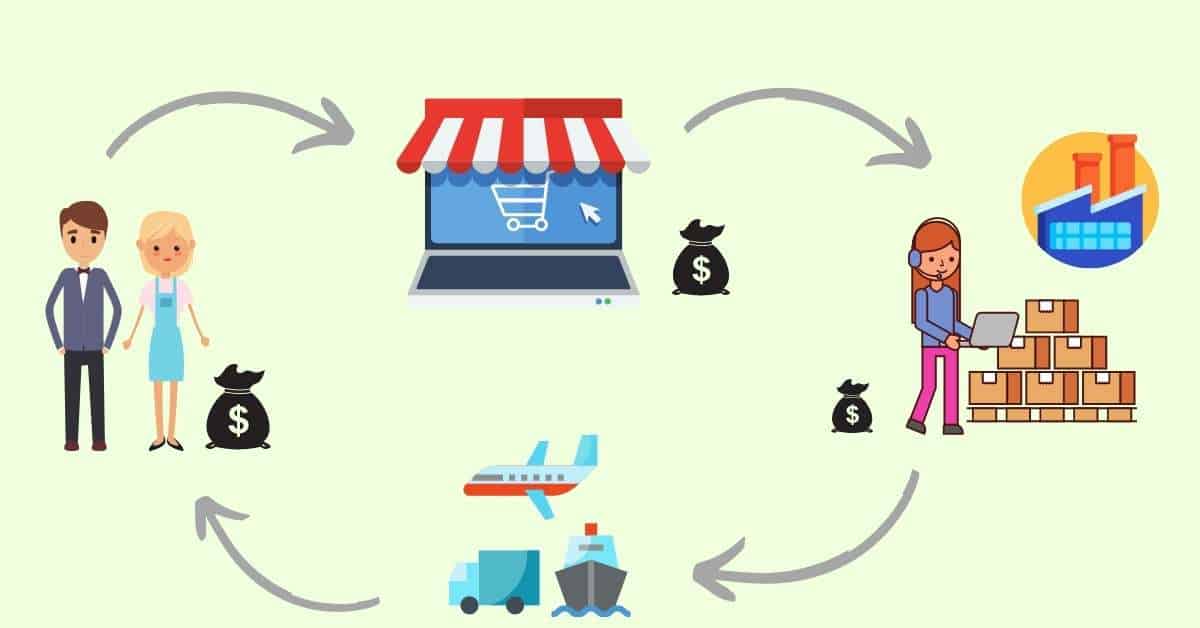
Are you perhaps open to exploring potential alternatives to leave your 9 – 5s in the dust? Then dropshipping is one of the most secure and feasible options to achieve that and more!
Over the years, drop shipping has proven to be a relatively low-risk business model that can surge your financial capability and propel you from zero to hero within just a few work hours daily. What’s even more compelling is that it requires no big investment.
Fascinated with this idea? Well, you should be. Keep reading as this article covers a concise, straightforward, yet detailed guide on everything you need to know about dropshipping.
Introducing dropshipping
Essentially, dropshipping business is a form of order fulfillment whereby store owners are not directly managing their inventories. In lieu, anytime a store sells a product by dropshipping, it buys the product from a third party and ships it directly to the customer without having custody of the item at any point in time.
In 2019, GlobalNewsWire reported a valuation of $162.44 billion for the dropshipping market. Besides, the relatively budding industry is projected to attain a massive $591.77 billion by 2027. Thus, considering the promise this space holds, suppose you are intending to launch an e-commerce store; you may want to consider drop shipping as your order fulfillment method.
How Shopify dropshipping works
In this guide, we will be using Shopify as a case study. Two of the prevalently adopted drop shipping strategies on Shopify are:
- Trying to find a North American supplier or a supplier located anywhere globally, if possible close to your target audiences and potential customers, to reduce the delivery time.
- Find out a Shopify application that links your eCommerce store to a range of suppliers.
Considering the second option, your best bet is Oberlo. Oberlo is a Shopify app well known for its ability to assist independent store owners and entrepreneurs in identifying viable product options for sale. Using Oberlo, you can access AliExpress, go through your preferred products and export them to Oberlo. Oberlo is linked to your Shopify store, and you can import these products with just a click.
As such, you can easily fulfill orders using Oberlo anytime a customer purchases the product. And luckily, the entire process is automated. As a store owner, the only action required of you is verifying the details and selecting the “order” button. Then, the Aliexpress supplier sends the item directly to the relevant customer, irrespective of their location worldwide.
Upsides of dropshipping

Are you considering becoming a dropshipper? You definitely should! Here is why.
Dropshipping has grown to be an excellent business model for nascent entrepreneurs to begin their entrepreneurial journey due to its accessibility. Adopting this model, you can easily try diverse business ideas with relatively narrow downsides, allowing you to gain more insights into selecting and marketing in-demand items.
Asides from this, here are other reasons you might want to consider dropshipping stores as your eCommerce model.
- Cost-effective and negligible capital required: Arguably, the greatest benefit of dropshipping is the opportunity it offers for anyone to launch an eCommerce store without high capital requirements, as opposed to what the traditional retailing model emphasizes. Implementing this model, as a store owner, there is no need to buy an item until you’ve sold it and the customer has fully paid for the product. With as little as a few hundred dollars, you can kickstart a dropshipping business.
- Accessibility: Since you don't have to deal with physical products, kickstarting an eCommerce implementing the dropshipping model is relatively easy. Essentially, you don't have to bother yourself about shipping and packaging orders, the costs of renting a warehouse, inbound shipments, and inventory tracking.
- Flexibility: As you could probably infer from how this model works, you can run it from anywhere globally should you have reliable internet connectivity. In as much as there are reliable communication media between you and your customers, this model is available for anyone and anywhere.
- Scalability: By adopting dropshipping, you can expand your reach with lesser incremental efforts as well as more negligible growing pains since the responsibility of most processes involved in processing extra orders lie on the supplier.
- The vast available product range: Offering a vast range of trendy items is feasible via dropshipping as it doesn't require you to pre-purchase any product you intend to sell. Thus, suppose a supplier stocks a product. In that case, you can easily list such products for sale on your eCommerce store. Of course, at no extra cost.
Downsides of dropshipping

- Potential shipping complications: Suppose you source your products from a supplier. Estimating shipping costs is somewhat straightforward. However, when you, as a drop shipper, use multiple suppliers for various products, calculating shipping costs and using various billing systems may birth intricacies in your efforts.
- Restricted control over branding: As a dropshipper, your reach related to customization is somewhat limited. Of course, you can create an appealing website with the right descriptions. You can use top-notch photoshoots of the products if you want to take a step further with branding. However, considering packaging and product instructions, you cannot do so much.
- Customer support can be relatively inconvenient: While it’s nice that you don't have to oversee your inventory yourself, it's only great until an angry customer files a complaint. Thus, even if your supplier disappoints you, the fault is on you. Therefore, always get ready to offer a deep apology and seamless customer support to steer clear of negative reviews. Brace yourself! You’re in for a long ride.
- Negligible profit margin: Considering the somewhat negligible entry threshold, you will be subject to competition. As such, until you can establish a reliable and robust customer base, you may want to lower your prices to gain a competitive advantage over your competitors or give ears to branding to differentiate your business.
On top of that, since you buy your products individually from your suppliers, you pay more per unit compared to a bulk order, which ultimately reduces your profit margin.
Finally, you need to consider the pretty sizable marketing costs required to promote your store, especially if you use paid advertising like Facebook Ads or Google Ads. This will be your biggest cost since driving traffic to your Shopify store is the most significant challenge and effort required for your business to thrive.
- Errors from suppliers: Even the most reliable suppliers are prone to mistakes related to order fulfillment. And as mentioned earlier, you may have to be responsible for it. This may trigger unending frustrations of faulty shipments and shoddy packaging, which can ultimately impact your reputation adversely.
How much do you need to kickstart dropshipping?
Here is a breakdown of the costs required to run a Shopify dropshipping store:
- Online store: roughly $29 monthly
- Domain name: $5 to $20 yearly
- Test orders: cost may vary depending on a range of factors
- Online advert: you may budget this depending on your financial capacity
Bottom Line: will drop shipping still make you money in 2025?
First off, it's important to note that this eCommerce model is a 100% legit venture. However, as highlighted in this concise guide, it is not perfect. It has its fair share of stress and hard work.
While the model is accompanied by diverse compelling benefits, it also has several intricacies you might be required to tackle. All in all, starting a dropshipping store is undoubtedly worth it today, and it shows the promise of a future-proof model.
